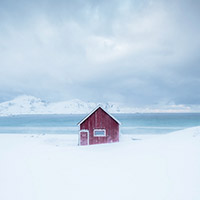Video: How to set up your camera for landscape photography
posted Thursday, March 31, 2022 at 4:00 PM EDT

Depending on what type of images you're shooting, you may want to set up your camera differently. Many modern cameras allow users to save custom settings to specific shooting modes or custom shortcut buttons. How should you set up your camera if you're doing landscape photography? Photographer Andy Mumford released a video guide showing how he sets up his Fujifilm X cameras for landscape photography.
While Mumford uses Fujifilm cameras, like the Fujifilm X-T4 and Fujifilm X-S10, a lot of what he discusses can be applied to cameras from other manufacturers. Topics like shooting RAW and reading histograms apply to all cameras, no matter the brand. Speaking of file quality settings, Mumford says, 'The most important thing is that you shoot your images in RAW format and not in JPEG.'
For advanced photographers, you already know the advantages of RAW, but for beginners, the basic version is that RAW images allow extensive flexibility during post-processing. JPEG files bake in certain settings, whereas RAW files don't. Adobe writes, 'A RAW file is lossless, meaning it captures uncompressed data from your camera sensor. Sometimes referred to as a digital negative, you can think of a RAW file as the raw "ingredients" of a photo that will need to be processed to bring out the picture's full potential. As you might expect, the tradeoff for these detailed files is that RAW files are quite a bit larger than JPEG files. Still, most professional photographers shoot in RAW because it gives them more information to work with in the post-processing phase.' Long story short, shoot RAW. Shoot RAW+JPEG if you want the ease of use of a JPEG file, but always shoot RAW.
While shooting RAW will allow you additional flexibility for editing your photos and adjusting how it looks, including exposure and brightness, it's still best to get the correct exposure in the camera. After all, you want to ensure that you have shadow and highlight data available for editing. Mumford opts for manual exposure and, when possible, base ISO. Base ISO varies by camera, but it's often between 64 and 200. At base ISO, your sensor behaves at its optimal level with the best possible dynamic range. If you're using a tripod, which you should be doing when possible, you have a lot of flexibility with shutter speed. If you're handholding, you need to shoot at a fast enough shutter speed to counteract hand movement. In most situations for landscape photography, you'll be controlling your exposure primarily by changing your shutter speed. You can also change your aperture to affect the amount of light that enters your sensor, but your primary concern with aperture is achieving the right depth of field for a given scene, rather than using aperture to control the exposure.
If you'd like to learn more about the exposure triangle that Mumford discusses above, comprising ISO, shutter speed and aperture, check out this in-depth article by Todd Vorenkamp over at B&H.
Like with his exposure, Mumford typically shoots landscape images using manual focus. If you've been hesitant to manual focus, it's worth giving it a try. Many modern cameras include built-in tools to help you nail perfect focus, including the ability to zoom in on your focus point in live view and use focus peaking. Some cameras even let you change the sensitivity of focus peaking, making it more useful. Even if you choose to stick with autofocus for most landscape situations – which is what I do – being able to focus manually is extremely helpful in low light or challenging situations that trip up even the best autofocus systems.
There are many more key settings for landscape photography, including metering, long exposure noise reduction, bracketing, histograms and more. Be sure to watch Mumford's full video above to get the full breakdown. If you like Mumford's video and want to see more, subscribe to his YouTube channel. To view more of his excellent landscape photography, visit his website and follow him on Instagram. You can also check out his upcoming workshop schedule by clicking here.
(Via Andy Mumford)